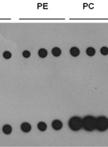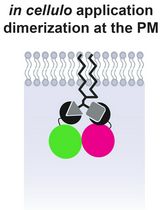- EN - English
- CN - 中文
Quantitative Analysis of Cellular Diacylglycerol Content
细胞中甘油二酯含量的量化分析
发布: 2014年08月05日第4卷第15期 DOI: 10.21769/BioProtoc.1202 浏览次数: 12526
Abstract
Diacylglycerol (DAG) is a bioactive lipid with diverse biological roles. DAG transiently accumulates in a membrane upon receipt of an appropriate stimulus that activates phospholipase C to cleave phospholipids. The resulting hydrolysis product DAG binds to proteins such as protein kinase C to initiate a variety of downstream cellular processes. DAG kinases attenuate such responses by converting DAG to phosphatidic acid.
This protocol describes an assay designed to quantify cellular DAG levels. The assay exploits the enzymatic conversion of DAG (sn-1,2-diacylglycerol) to phosphatidic acid (1,2-diacyl- sn-glycerol-3-phosphate) in conjunction with the incorporation of a radiolabeled phosphate group by DAG kinase (Figure 1). This assay was described in (Strijbis et al., 2013).

Figure 1. The enzymatic conversion of DAG to phosphatidic acid by DAG kinase
Materials and Reagents
- Cells (~2 x 106 cells)
- Octyl-β-D-glucoside (Sigma-Aldrich, catalog number: O8001 )
- Cardiolipin (Sigma-Aldrich, catalog number: C5646 )
- Diethylenetriaminepenta acetic acid (DETAPAC) (Sigma-Aldrich, catalog number: D6518 )
- Imidazole (Sigma-Aldrich, catalog number: I5513 )
- NaCl (Sigma-Aldrich, catalog number: S7653 )
- MgCl2 (Sigma-Aldrich, catalog number: M8266 )
- EGTA (Boston Bio Products, catalog number: BM-151 )
- DTT (Sigma-Aldrich, catalog number: D0632 )
- DAG kinase (Sigma-Aldrich, catalog number: D3065 )
- γ33-ATP (PerkinElmer, catalog number: NEG302H001MC )
- DAG (Avanti Polar Lipids)
- Phosphatidic acid (Sigma-Aldrich, catalog number: P9511 )
- Chloroform (Thermo Fisher Scientific, catalog number: C298-50 )
- Methanol (Thermo Fisher Scientific, catalog number: BP1105 )
- Acetic acid (Sigma-Aldrich, catalog number: 695092 )
- N2 gas (Middlesex Gases & Technologies)
- Acetone (Thermo Fisher Scientific, catalog number: S70090 )
Equipment
- Vortex
- Centrifuge
- Thin layer chromatography (TLC) (Whatman, catalog number: 4860-820 ) equipment (plates, developing tank)
- Phospho-scanner (e.g. Fujifilm Corporation, model: BAS-2500 )
- Phospho-imaging screens (e.g. Fujifilm Corporation, model: BAS-MS )
Procedure
文章信息
版权信息
© 2014 The Authors; exclusive licensee Bio-protocol LLC.
如何引用
Readers should cite both the Bio-protocol article and the original research article where this protocol was used:
- Tafesse, F. G., Strijbis, K. and Ploegh, H. L. (2014). Quantitative Analysis of Cellular Diacylglycerol Content. Bio-protocol 4(15): e1202. DOI: 10.21769/BioProtoc.1202.
- Strijbis, K., Tafesse, F. G., Fairn, G. D., Witte, M. D., Dougan, S. K., Watson, N., Spooner, E., Esteban, A., Vyas, V. K., Fink, G. R., Grinstein, S. and Ploegh, H. L. (2013). Bruton's Tyrosine Kinase (BTK) and Vav1 contribute to Dectin1-dependent phagocytosis of Candida albicans in macrophages. PLoS Pathog 9(6): e1003446.
分类
生物化学 > 脂质 > 脂质测定
生物化学 > 脂质 > 脂质分离
生物化学 > 蛋白质 > 相互作用 > 蛋白质-脂质相互作用
您对这篇实验方法有问题吗?
在此处发布您的问题,我们将邀请本文作者来回答。同时,我们会将您的问题发布到Bio-protocol Exchange,以便寻求社区成员的帮助。
Share
Bluesky
X
Copy link












